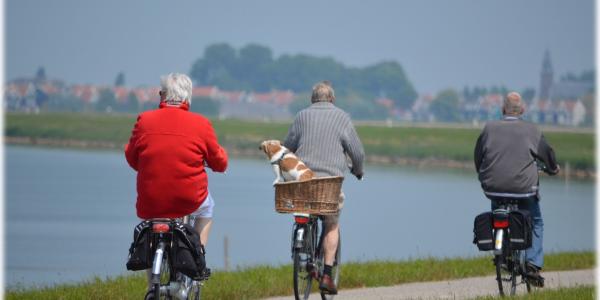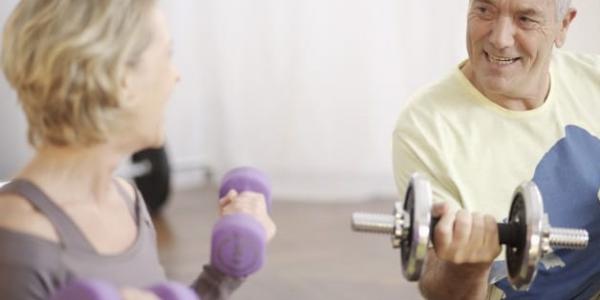Bend, Not Break: The Importance of Maintaining Flexibility

You may not think about it often, but flexibility impacts our everyday lives. Learn more about the physiology of flexibility and why you should consider making stretching part our your routine.
Did you participate in the Presidential Physical Fitness Test as a kid? I did, and I have a clear memory of the test from fourth grade that still sticks with me.
If you’re not familiar with the Presidential Fitness Test, it was an annual fitness evaluation administered to public schoolchildren during physical education class (I say ‘was’ because the test was discontinued in 2012). It involved the usual battery of fitness benchmarks: pushups and sit-ups, running and jumping. I generally enjoyed the challenge, and did pretty well- but there was one feat that I found particularly vexing: the sit-and-reach. The test involves sitting on the floor with your legs extended straight in front, bottoms of the feet flat against a small box. The box had a ruler affixed to its top. Reaching as far forward as possible, the PE coach would score your flexibility by measuring how far your outstretched fingertips reached onto the ruler. Simple stuff, right?
For me, this test should have been called the sit-and-out-of-reach, because I was never able to touch the ruler. Looking back, I’m not sure I’ve ever been able to touch my toes, let alone reach beyond them. Meanwhile, I had classmates that could easily stretch beyond the soles of their shoes. All these years later I still remember sitting on the gym floor, heaving forward with my arms outstretched, only to being able to graze my shoelaces. I got the Presidential Fitness Award that year, but my inflexibility complex has stuck with me until this day. But is that fair?
The term ‘Flexibility’ refers to the body’s ability to move a joint (or series of joints) fully and painlessly through a natural range of movement. In more practical terms, some degree of flexibility is required to comfortably perform everyday activities. Simple things like getting out of bed, bending down to tie a shoe, or reaching for an overhead shelf are all movements that require your joints to move through their range of motion.
As flexibility wanes, daily activities become more difficult. We know that flexibility tends to decrease as we age, and a sedentary lifestyle can hasten this decline. Loss of flexibility can lead to physical issues: chronic pain, balance disorders, and ultimately, loss of independence. On the flip side, quality of life can be enhanced by improving and maintaining a good range of motion in the joints. People of all ages and activity levels benefit from flexibility training!
So back to my woes with the sit-and-reach. Why was it that some of my classmates effortlessly reached beyond their toes, scoring well on this test- when I could barely manage to graze the tongues of my shoes? As it turns out, there are several factors that influence individual flexibility. Age, genetics, and sex (females tend to be more flexible than males) are all major variables. Musculoskeletal structure, previous tissue injury, body temperature, and activity level are a few secondary factors. The bottom line is, natural flexibility (like strength and endurance) varies greatly from person to person. Of course, we know that inflexible bodies can become more limber through stretching.
There are a number of reasons to stretch: improving flexibility and range of motion, correcting posture, preparing our bodies for physical activity, and reducing muscle soreness. Consistent stretching helps keep our muscles strong, elastic and healthy. A mindful stretching practice like yoga can be great for both mental and physical wellbeing. Stretching is also instinctual and engrained into our movement patterns. Think about the first thing you do when you wake up and roll out of bed. Is it a big stretch and yawn? How about when you get out of the car after a long drive? Again, do you have the urge to stretch?
Getting started with a stretching routine is a great way to improve flexibility and enhance quality of life. The American College of Sports Medicine (ACSM) recommends that adults perform flexibility exercises at least two to three times per week. This approach could include practicing Yoga, Tai Chi, Pilates, or simply stretching on its own. Try to hit the major groups of the body: ankles, legs, hips, back, core, chest, shoulders, arms, and neck. Stretch each muscle group for a total of 30 seconds. Before we dive deeper, it should be noted that incorrect stretching can be dangerous because not all stretches are appropriate for every muscle group. Stretching the wrong joint in the wrong manner can damage muscles, ligaments and tendons. Let’s take a quick look at the major stretching types and how to safely use them. We’ll start with basic stretching techniques that anyone can practice:
Static: The old classic. This involves stretching a body part to its farthest position and then holding the stretch for 30 seconds. There is no bouncing or movement, hence the name ‘static’. You should feel the stretch through the length of the muscle, and not in the joints. Think of the stretching you did in gym class.
Although static stretching has been a mainstay in warmup routines, a 2013 study indicated that it might actually weaken muscles. For this reason, dynamic stretching is recommended before exercise. Static stretching is useful as a recovery tool, but should not be considered your warmup.
Dynamic: The opposite of a static stretch, this involves the controlled movement of a joint through its natural path, gradually increasing speed and range (or both) of the movement. Dynamic stretches help improve range of motion, loosen the muscles, increase blood flow, and is the best option to prepare the body for athletic activity. Leg swings, arms circles, and torso twists are all good examples. The key is controlled movement that doesn’t overextend the joints.
*Please note that the next two stretching techniques described should only be used by people with an established intermediate to advance stretching practice, or under the guidance of a qualified professional. These movements can lead to injury if performed incorrectly.*
PNF: Proprioceptive Neuromuscular Facilitation (PNF) is a three-phase stretching technique that involves stretching a muscle, then forcefully contracting it, then stretching again. PNF is effective because of the contraction phase. Our muscles have sensory receptors called Golgi Tendon Organs that relay signals to the brain. They are essentially a safety net that protect our muscles from tearing by signaling the brain to ‘relax’ when too much tension is being applied to a muscle. This phenomenon is called autogenic inhibition, and by contracting the muscle forcefully, you trick the brain into relaxing that muscle a bit more than it normally would. The muscles that are now ‘relaxed’ will stretch farther, deepening the stretch. Done repeatedly, this increases range of motion and flexibility. This technique began as a physical therapy tool, but is moving more into the world of mainstream of fitness.
Ballistic: Similar to dynamic, but taken a step further. Ballistic stretching involves using momentum to force a joint or muscle group beyond its normal range of motion. These movements can increase the potential for injury if not performed correctly. Ballistic stretching should only be performed by skilled and highly trained athletes. Ballistic stretching has its purpose, however most people should avoid it and stick with dynamic (warmup) and static stretching (post-exercise).
Ready to improve your flexibility and make stretching a part of your everyday routine? Think you deserve another crack at the sit-and-reach? Check out the resources below to get started, or join an Active Stretching Class with Health4U! http://health4u.msu.edu/courses/active-stretching
MSU Rehabilitation Desk Stretches
http://www.rehab.msu.edu/wellness/Videos/desk.html
Mayo Clinic Guide of Basic Stretching
https://www.mayoclinic.org/healthy-lifestyle/fitness/multimedia/stretching/sls-20076840
5 Minute Stretch
https://www.healthline.com/health/fitness-exercise/daily-stretching-routine#8
10 Minute Stretch
https://blog.fitbit.com/daily-stretching-sequence/Related Articles

Want a better night’s sleep? Get Moving!
The connection between exercise and sleep is very real. This article examines current research, and how your everyday activities may be influencing sleep patterns.
.jpg)
Physical Literacy: The Foundation for a Life of Movement
Early development of physical literacy is linked to future success in sport and activity participation. In the long run, establishing active habits in children sets them on the path to happier and healthier lives.

A Brief Guide to the Body's Aerobic System
Aerobic exercise is a cornerstone of physical wellness. Learn more about the function of the aerobic system and the role it plays in supporting good health.

Strength Training: Lift Your Way to Better Health
If your workout doesn’t include strength training, you’re missing out. Strength training can ward off age-related muscle loss, keep your bones strong, promote mobility and function, and even help combat depression and cognitive decline.





